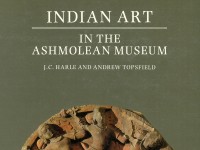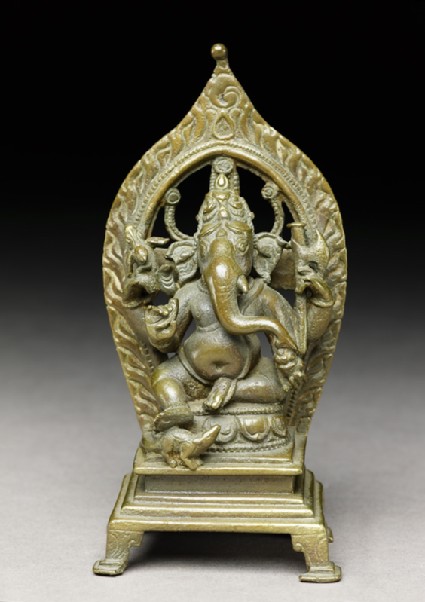Indian Art in the Ashmolean Museum
A catalogue of the Ashmolean’s collection of Indian art by J. C. Harle and Andrew Topsfield (published Oxford, 1987).

Publications online: 143 objects
Figure of Ganesha
-
Literature notes
Gaṇeśa, the elephant-headed god, is four armed and seated in a relaxed position (lalitāsana), one leg drawn up on his lotus pedestal, the other hanging down as much as the god’s excessive chubbiness will permit. His vehicle, variously described as a rat, mouse or shrew, near his right foot, gazes up at him. As in [EA1980.64], the god’s crown appears to be interwoven with his long locks of hair (?) into a jạtā-mukuṭa. In his lower right hand he holds the broken end of his right tusk, in his left is the bowl from which Gaṇeśa, as in almost all images of this god, is picking some little round cakes with his trunk. His left rear hand holds the axe (paraśu), the right what is probably a radish (mūlaka) with a little hooded serpent head beside it.
Below the circular lotus pedestal is a stepped, four legged throne and there is a drop-shaped bezel for a jewel near the apex of the prabhāvali. -
Details
- Associated place
-
Asia › India › east India (place of creation)
- Date
- 9th - 10th century AD (AD 801 - 1000)
- Material and technique
- bronze
- Dimensions
- 12.7 x 6.2 x 5 cm max. (height x width x depth)
- Material index
-
processed material › metal › alloy › copper alloy › bronze
- Technique index
- Object type index
- No. of items
- 1
- Accession no.
- EAX.182
-
Further reading
Harle, J. C., and Andrew Topsfield, Indian Art in the Ashmolean Museum (Oxford: Ashmolean Museum, 1987), no. 43 on pp. 35-36, pp. 11 & 29, illus. p. 36
Glossary
Ganesha
-
Ganesha
Chubby elephant-headed Hindu deity and son of Shiva and Parvati. He is the god of wisdom, bestower of wealth, and remover of obstacles who is invoked at the beginning of any enterprise.
Location
Objects are sometimes moved to a different location. Our object location data is usually updated on a monthly basis. Contact the Jameel Study Centre if you are planning to visit the museum to see a particular object on display, or would like to arrange an appointment to see an object in our reserve collections.
Publications online
-

Indian Art in the Ashmolean Museum
Gaṇeśa, the elephant-headed god, is four armed and seated in a relaxed position (lalitāsana), one leg drawn up on his lotus pedestal, the other hanging down as much as the god’s excessive chubbiness will permit. His vehicle, variously described as a rat, mouse or shrew, near his right foot, gazes up at him. As in [EA1980.64], the god’s crown appears to be interwoven with his long locks of hair (?) into a jạtā-mukuṭa. In his lower right hand he holds the broken end of his right tusk, in his left is the bowl from which Gaṇeśa, as in almost all images of this god, is picking some little round cakes with his trunk. His left rear hand holds the axe (paraśu), the right what is probably a radish (mūlaka) with a little hooded serpent head beside it.
Below the circular lotus pedestal is a stepped, four legged throne and there is a drop-shaped bezel for a jewel near the apex of the prabhāvali. -

Indian Art in the Ashmolean Museum
Gaṇeśa, the elephant-headed god, is four armed and seated in a relaxed position (lalitāsana), one leg drawn up on his lotus pedestal, the other hanging down as much as the god’s excessive chubbiness will permit. His vehicle, variously described as a rat, mouse or shrew, near his right foot, gazes up at him. As in [EA1980.64], the god’s crown appears to be interwoven with his long locks of hair (?) into a jạtā-mukuṭa. In his lower right hand he holds the broken end of his right tusk, in his left is the bowl from which Gaṇeśa, as in almost all images of this god, is picking some little round cakes with his trunk. His left rear hand holds the axe (paraśu), the right what is probably a radish (mūlaka) with a little hooded serpent head beside it.
Below the circular lotus pedestal is a stepped, four legged throne and there is a drop-shaped bezel for a jewel near the apex of the prabhāvali.
Galleries
Notice
Object information may not accurately reflect the actual contents of the original publication, since our online objects contain current information held in our collections database. Click on 'buy this publication' to purchase printed versions of our online publications, where available, or contact the Jameel Study Centre to arrange access to books on our collections that are now out of print.
© 2013 University of Oxford - Ashmolean Museum






